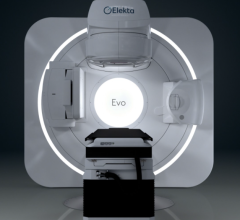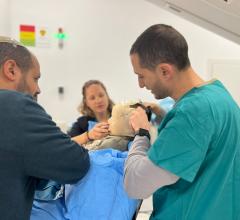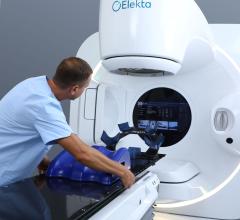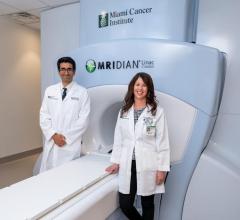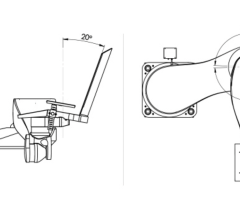
The center expanded the craniopharyngioma CTV target by 3-mm since using the Trilogy face mask and bite block immobilization system for the treatment.
Since its introduction two years ago, Varian’s RapidArc radiotherapy technology has been deployed at over 170 cancer centers around the world.
RapidArc delivers an image-guided intensity-modulated treatment with one or more arcs of the linear accelerator gantry around the patient. During treatment the RapidArc software varies three parameters simultaneously to arrive at the prescribed dose distribution: the MLC aperture, the dose rate, and the speed of gantry rotation. Many treatments can be completed with one rotation of the machine; some complex treatments require multiple rotations. For radiosurgical treatments, RapidArc can be delivered in multiple arcs, or with couch rotations for non-co-planar treatments.
Treating Craniopharyngioma, a Tumor of the Pituitary Gland
At The Center for Radiation Therapy of Beverly Hills, Christopher Rose, M.D., characterized a recent two-arc RapidArc case as “one of the most interesting uses of non-coplanar arcs I have seen so far.” His patient was a 47-year-old woman with a large craniopharyngioma, a tumor arising in or near the pituitary gland. The tumor was adhering to the undersurface of the optic chiasm and growing around it. A neurosurgeon was able to dissect out most of the huge (6 cm in diameter) tumor using a frontal approach, but was unable to remove some abnormal calcified epithelial cysts adjacent to and behind the chiasm.
Dr. Rose’s team merged the pre- and post-operative MRIs with the planning CT scan in order to treat the residual volume as well as those CNS surfaces that had been involved with craniopharyngioma pre-operatively. “We contoured the optic nerves, optic chiasm and optic radiations and put in a dose constraint that the daily dose to those structures and to other normal neural tissue could not be greater than 1.8 Gy per day,” he said. In addition, the prescription specified that at least 95 percent of the PTV needed to get 100 percent of the dose. “We expanded the craniopharyngioma CTV target by 3-mm since we were using the Trilogy face mask and bite block immobilization system for the treatment and we had never seen movement greater than 3 millimeters in similar cases with the infrared tracking,” Dr. Rose added.
“I had always wanted to use two orthogonal arcs to treat a patient like this — a standard brow rotation with extreme neck flexion to miss the eyes and then a sagittal arc to treat in a cranio-caudal orientation between the eyes. The planning was incredibly easy, the optimization of these two arcs worked like a charm, and after running the partial arc to treat the sagittal orientation two or three times on a phantom, the whole team gained confidence.”
According to Dr. Rose, the treatment plan was “incredibly conformal,” with the maximum dose within the PTV volume, 6 percent higher than the prescription dose. “None of the normal neural tissue within the invaginations of the PTV received more than 1.8 Gy per day. The medial temporal lobes received a maximum of 50 percent of the PTV dose and the frontal lobes received only 30 percent of maximum dose. The dose was higher than the 45-50.4 Gy dose in the literature and the normal tissue dose was much less. Even with the need to go into the room to rotate the treatment couch 90 degrees for the sagittal arc the entire treatment — including daily imaging — took less than 10 minutes!”
Lung Cancer
Doctors at the VU Medical Center in Amsterdam have been pioneering RapidArc treatments for lung tumors. Their stereotactic treatments for early stage lung tumors, details of which have been published in Radiotherapy and Oncology, began last year.
“The average delivery time using our standard non-coplanar beams was previously around 15 minutes for these complex cases, but nearly a third of patients required an additional set-up procedure during delivery as a consequence of intra-fraction shift,” said Suresh Senan, Ph.D., professor of clinical experimental radiotherapy. “With RapidArc we have reduced delivery times to between 4.5 and 11 minutes, depending on the risk-adapted fractionation scheme used. We hope to reduce treatment times further to less than six minutes for all cases by the end of this year.”
The additional time savings will come about using Varian’s Novalis Tx radiosurgery platform, with its linear accelerator that delivers up to 1000 monitor units (MU), combined with the recent RapidArc upgrade that places no restrictions on the number of MUs delivered per arc. “These improvements have put clear blue water between Varian’s system and rival solutions, as delivery times of between 22 and 100 minutes have been quoted by others for this indication in recent publications,” added Senan.
“We are also pleased with the highly conformal plans achieved with RapidArc, which allows us to further reduce doses to critical structures like the chest wall, especially for non-spherical tumors,” he said. “Even larger tumors are now being treated and our patients appreciate the ability to complete their sessions quickly.”
Ben Slotman, M.D., Ph.D., chairman of the hospital’s department of radiation oncology, added, “We have reported excellent results with lung stereotactic radiotherapy previously, but RapidArc has now allowed for improvements in departmental efficiency and cone-beam CT-guided setup on the tumor ensures that we are treating the tumors accurately.”
*Verbakel W, Senan S, Cuijpers J, Slotman B, Lagerwaard F. Rapid delivery of stereotactic radiotherapy for peripheral lung tumors using volumetric intensity-modulated arcs. Radiother Oncol. In press.
(This article is excerpted from a longer article that appeared in the October 2009 issue of Centerline, a magazine published by Varian Medical Systems for the clinical oncology community).

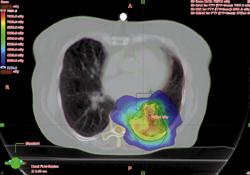

 December 02, 2025
December 02, 2025 



